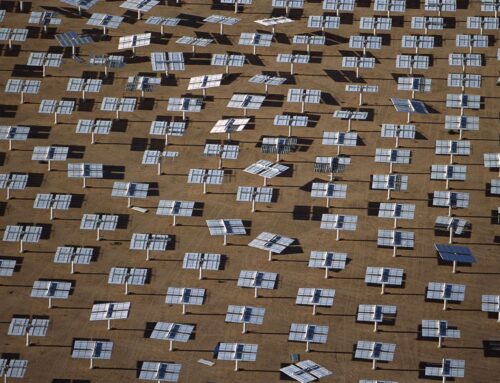Not just solar panels: Lessons from Medellín’s energy transition
April 29, 2025
The water of La Rafita stream tore through Medellín’s El Pacífico neighbourhood in Colombia on the afternoon of 18 September, 2020. Four houses were swept away and a dozen more ended up flooded.
“It was a total tragedy. When night fell, everything was dark. You couldn’t see,” recalls Nancy Quirós, a member of the Junta de Acción Comunal (Community Action Board), an elected local government that represents El Pacífico. Firefighters arrived at dusk and worked without street lighting to rescue those trapped in their homes.
The residents – mostly displaced victims of Colombia’s ongoing internal armed conflict, who had moved to the area seeking a better life – were used to living without street lighting, due to a lack of maintenance. They avoided going out after dark and, if necessary, used their mobile phones to illuminate the narrow concrete stairs that connect the houses. The tragedy of 18 September led them to seek a solution.
The first was a hydraulic turbine, constructed from spoons designed for eating mazamorra (a typical Medellín soup), a bicycle wheel and computer batteries. By connecting this system to a generator, they were able to produce the electricity that continues to light up the Junta de Acción Comunal headquarters. Next came eight solar panels, funded through a joint project with the Ministry of Science, Technology and Innovation.
By involving locals in the design, construction, installation and management of their own energy solutions, El Pacífico had aligned itself with the just energy transition. But it is not the only Medellín community exploring new energy sources. In Colombia’s second-largest city, there are at least three other initiatives linked to solar energy.
Not just about installing solar panels
The solar panels in Medellín’s hilly La Estrecha neighbourhood quickly gained unexpected fame. Local Rodrigo García recalls it was his son who brought the first panel home in 2020, to test a pilot project the pair had developed with the EIA University in Envigado, a municipality just south of Medellín. Once installed, the panel shrank the family’s energy bill by 20-30%.
Word soon got around. An additional 23 families joined in, and 46 panels were installed on the highest roofs of three houses.
However, in December 2023, the project ended. To prevent the loss of everything that had been achieved, the community organised itself. La Estrecha is now a distributed generator: it produces enough solar energy to sell it to traders.
Andrés Castaño, a legal representative of La Estrecha’s solar community, says they have since had to reckon with a lack of technical knowledge. It has made it difficult to interact with energy companies, and to involve more neighbours in the project.
This problem is not unique to La Estrecha. The leaders of the Huertas para la Paz (Gardens for Peace) project, which promotes community gardens, have also faced challenges. In 2021, a foundation gave them a solar oven that captures energy from the sun with mirrors. The accumulated heat can be used to cook food or – as is the case for this particular project – to dry out aromatic plants.
Esneda Ramírez, a community leader, says it has proven difficult to sustain the project because they have not been sufficiently trained in how to optimise the oven: “We need a technician to teach the theory of the importance of the oven, because we don’t know how to assess it. They explained to me how to use it, but the other people see that it is difficult, that it requires patience, and they don’t see the benefits that it can generate for us to make a living from it.”
Another obstacle has been the weather conditions. Medellín is often cloudy and rainfall is intermittent in its mountainous neighbourhoods. These conditions require them to be continually mindful of the oven’s positioning as the sun moves, and to shelter it during rain. Otherwise, the humidity can negatively impact the plant-drying process.
“The oven works well, but it is better in hot places like the coast, where there is a lot of sun. The climate here does not lend itself to quick drying,” says Ramírez. She says she is the only member of Huertas de Paz’s 16-strong team who has any faith in the solar oven project.
Energy autonomy means that we don’t depend on others but understand that we have the right to be part of the project
James Rúa, community leader of El Pacífico
To overcome these barriers, the Popular School of Autonomy (EPA) is putting on free training programmes in El Pacífico. They are tailored to the area’s energy needs and available energy-generation tools. This has enabled locals – including children – to understand how electricity is generated and participate in, for example, the construction of water wheels and the maintenance of solar panels.
“Energy autonomy means that we don’t depend on others but understand that we have the right to be part of the project,” says James Rúa, a community leader of El Pacífico. “It prevents anyone from discriminating against us and pushing us aside in a struggle that we are all engaged in.”
To promote just energy transition projects, all agree on the need for the community to have a sense of ownership. Previously, EIA University had tried to install panels in Medellín’s Comuna 13 neighbourhood. However, Comuna 13 was mostly populated by renters, which Rodrigo García says made it difficult to build a cohesive project.
Sofia Carvalho is part of Merlin Productions, a company that uses solar energy to power music production. She stresses the importance of building support networks: “This is an uncomfortable path, which may take more time, money and reflection, but it is necessary. You have to look for a support network, because this is a lonely road. Sometimes it is rowing against the current. With that network you share knowledge, actions and frustrations.”
None of the four initiatives consulted by Dialogue Earth have had contact between themselves, which underscores one of the current weaknesses of this movement in Medellín.
Merlin Productions has been linking solar panels to its work for two years (since the company Celsia gave the team a solar roof) and has become another distributed generator in the country. It has since produced La Sinfonía de los Bichos Raros (The Symphony of the Oddballs), its first record made with 100% renewable energy. The record is focused on transforming the public’s attitudes towards consumption and the rest of the natural world.
The challenges of transition in cities
Energy transition projects have focused on Colombia’s rural zones as a way of supplying electricity to areas that do not have it. But experts agree it is necessary to start promoting these initiatives in cities, too.
Juan Pablo Soler, a climate justice and energy researcher at the environmental organisation Living Water Census (CAV), points out that cities are where Colombia’s main energy demand is concentrated.
Soler says Colombia has been exploring energy transitions for more than 20 years, but these efforts have been limited by a lack of clear regulation and political will. He also questions the lack of justice for the communities that have driven these projects; he says associated incentives are often geared towards large, private companies and off-grid, rural areas. He adds that people in urban areas, such as Medellín, face additional challenges due to the common disconnect between the technological solutions on offer and the actual needs of communities.
Violeta Garrido, a philosophy researcher at the University of Granada, questions the fact that environmental and social transformation is seemingly based only on renewable energy initiatives. For her, technological solutionism (the belief that technology will solve environmental problems) creates a “culture of passivity” and “does not force us to change our patterns of production, distribution and consumption”
For now, the people of La Estrecha, El Pacífico and Merlin Productions face the challenge of sustaining their initiatives and attracting more interest. The key is to share knowledge and ensure that new generations take the lead in an energy transition that is truly just, learning from accumulated lessons.
“We are getting old, and with all that we have learned we have to tell the children that it is not difficult to do these energy projects,” says community leader Rúa. “They are also part of the community, and they are the ones who will be left on this planet when we are gone.”
This story was produced in the framework of the Narrar la TEJ (Narrating the Just Energy Transition) project, promoted by the organisations of the Energy Power Latam Alliance.
Search
RECENT PRESS RELEASES
Related Post








